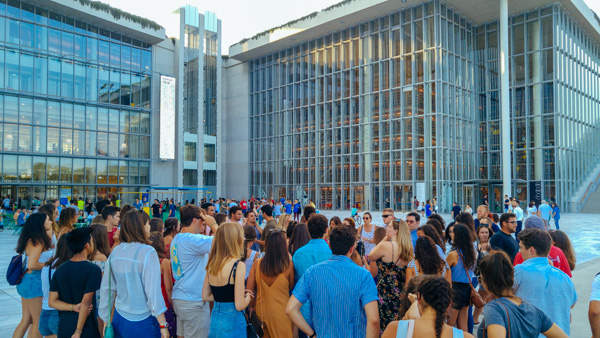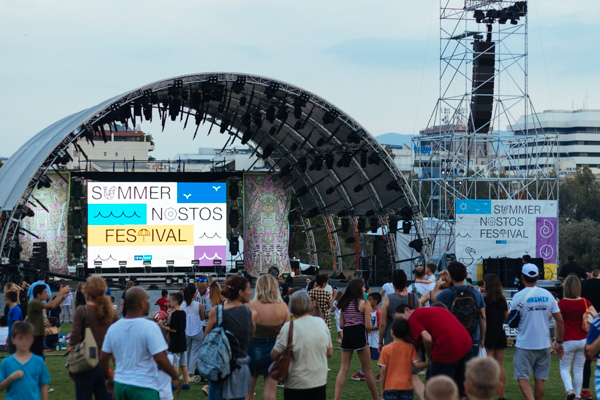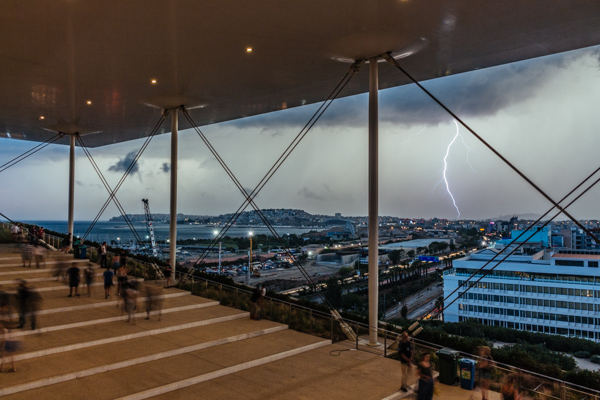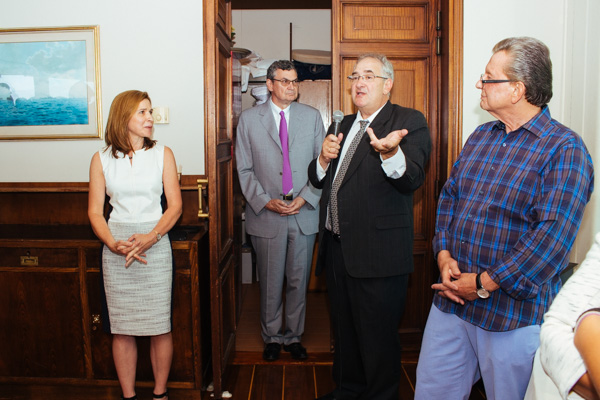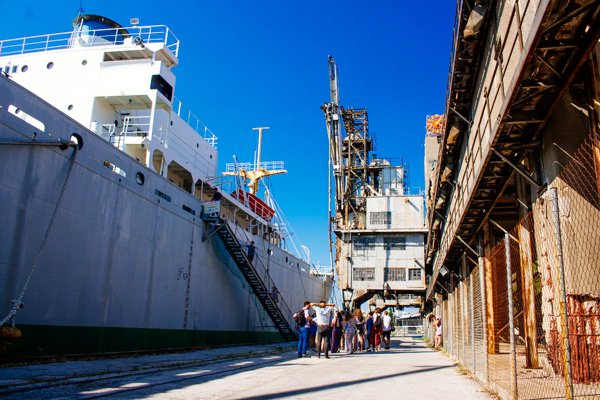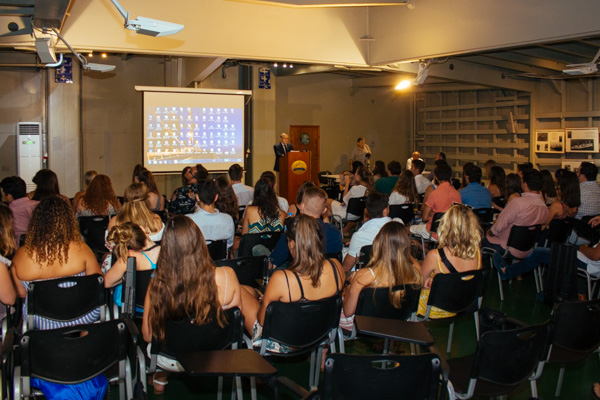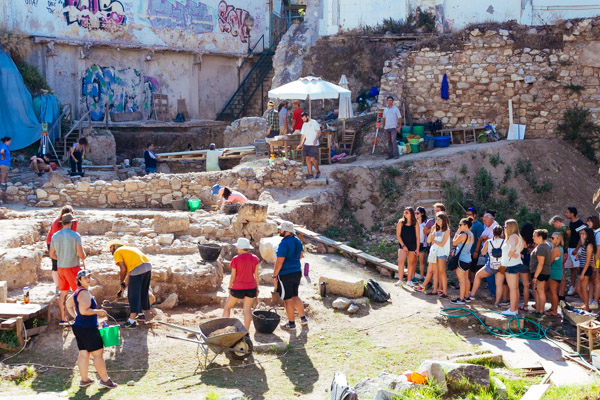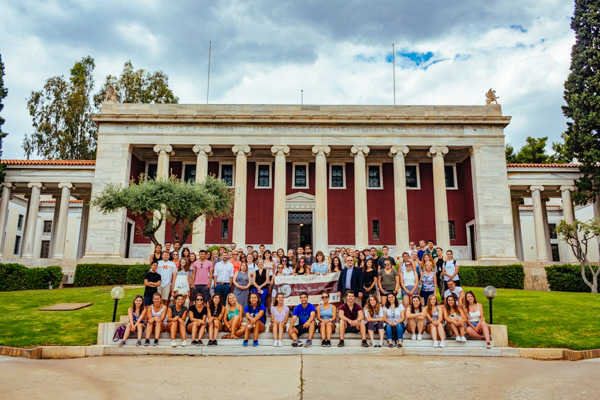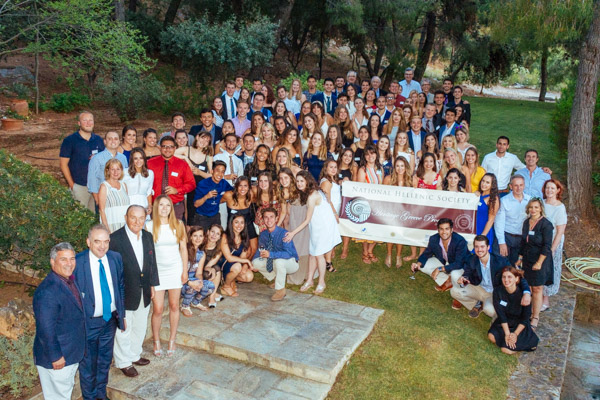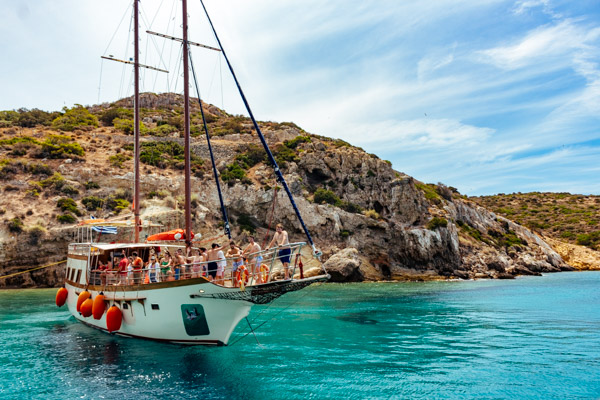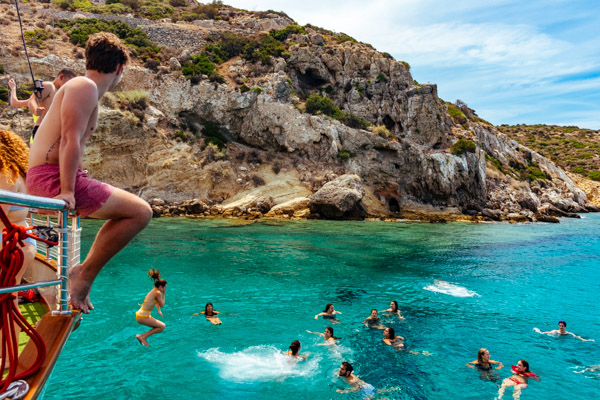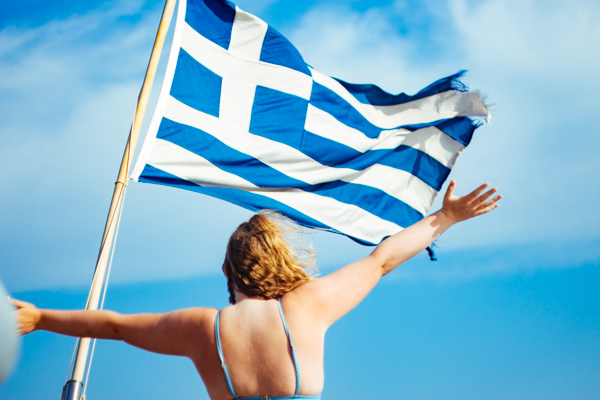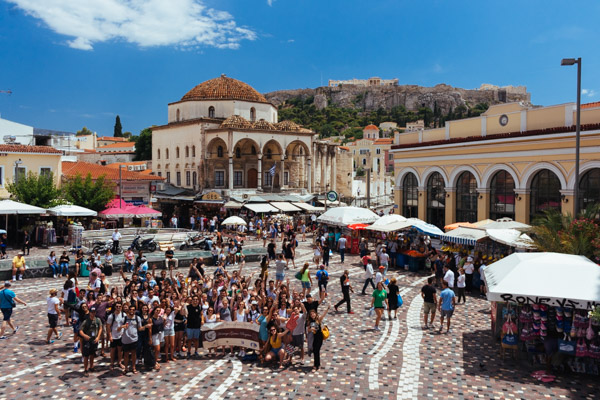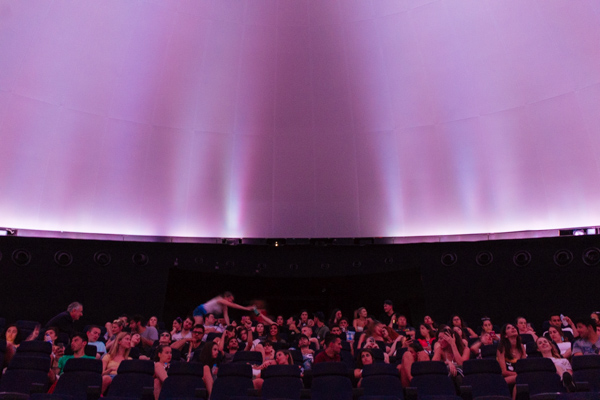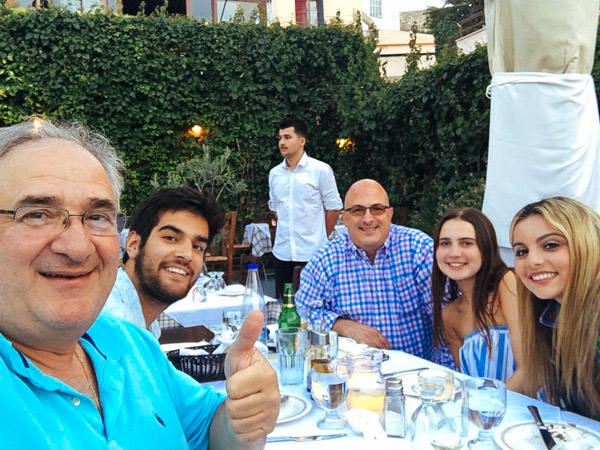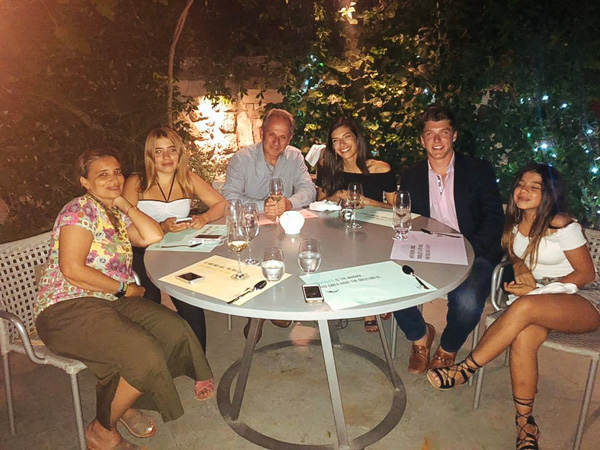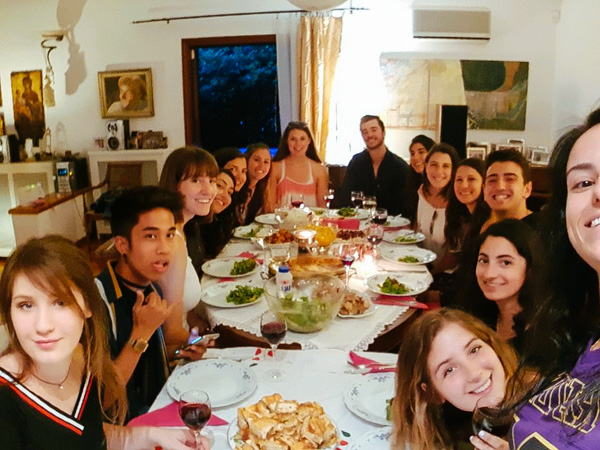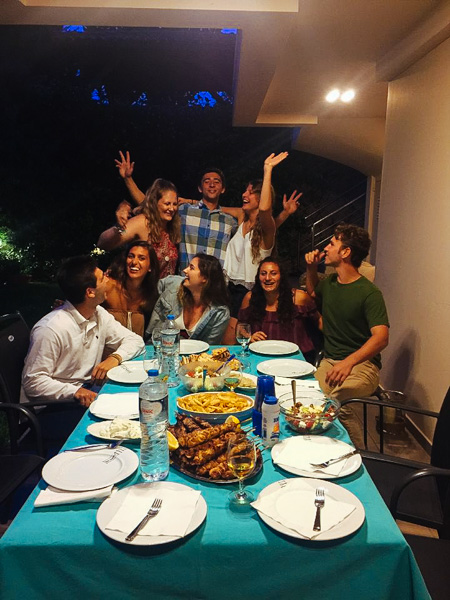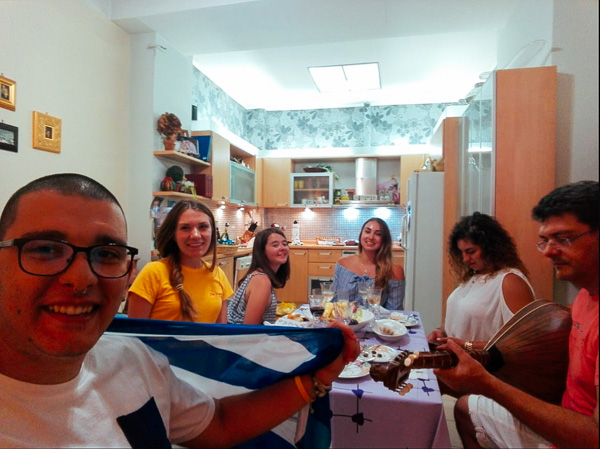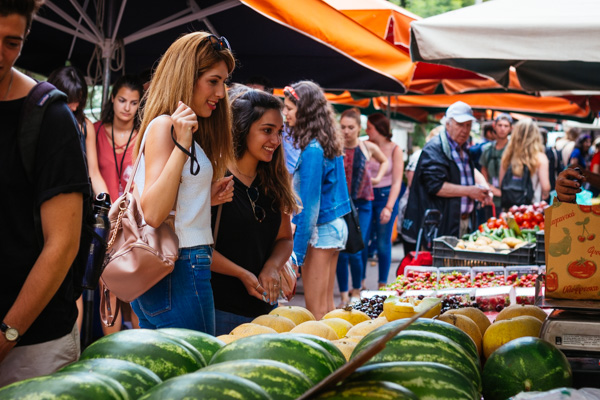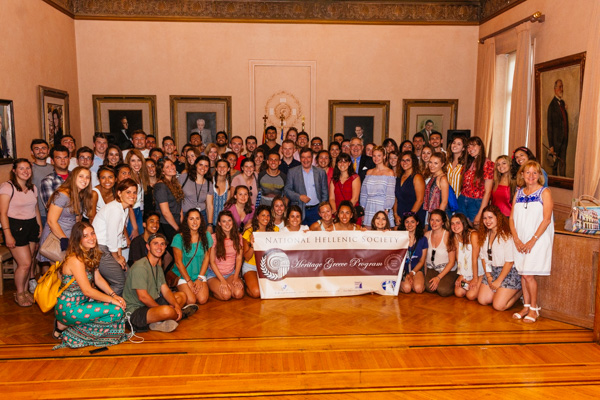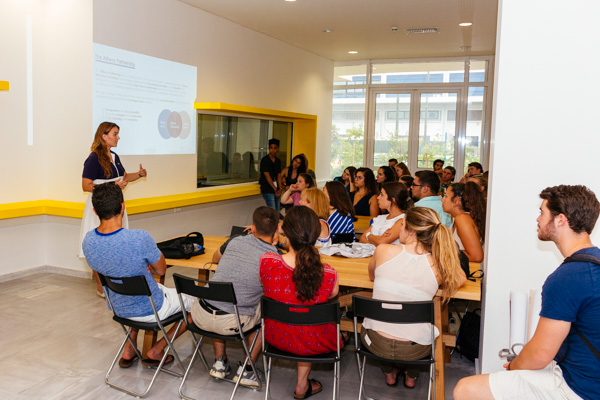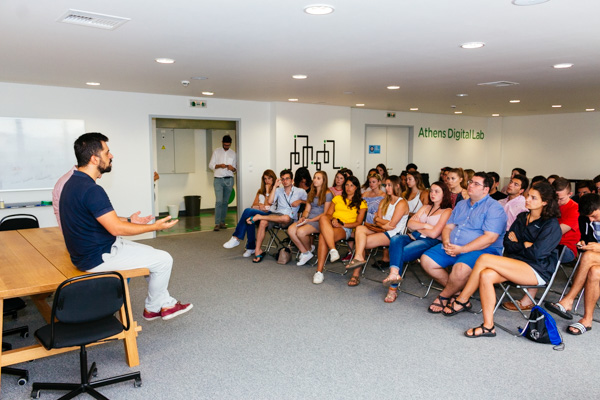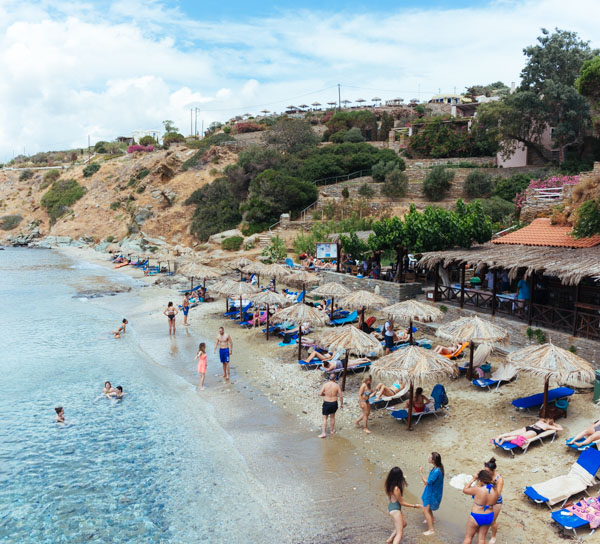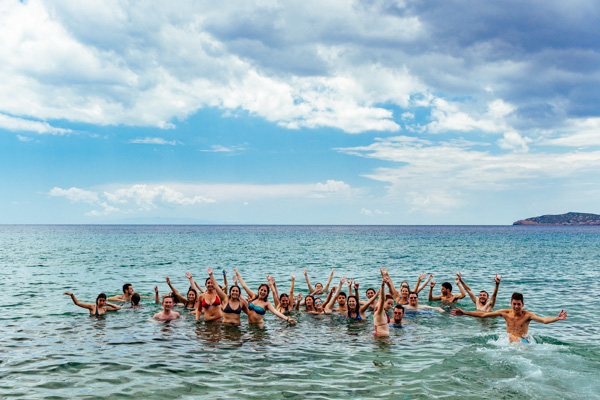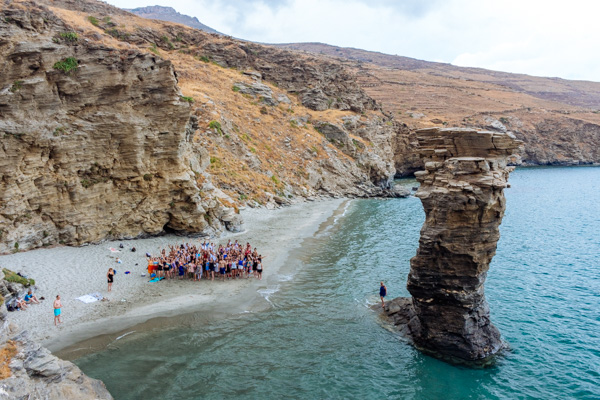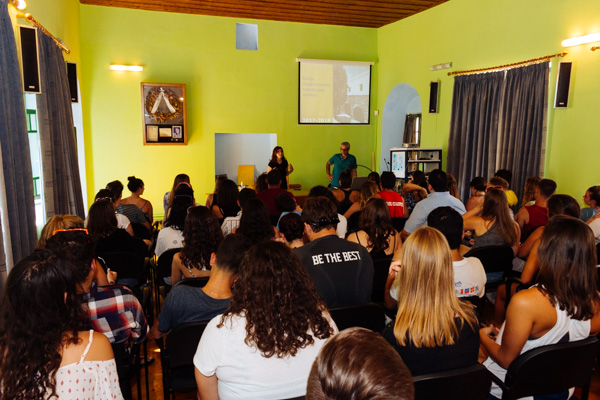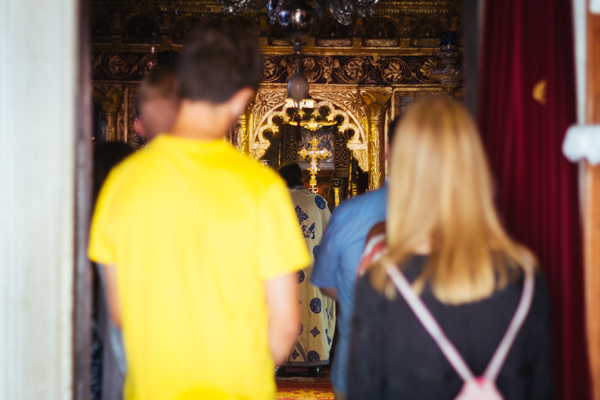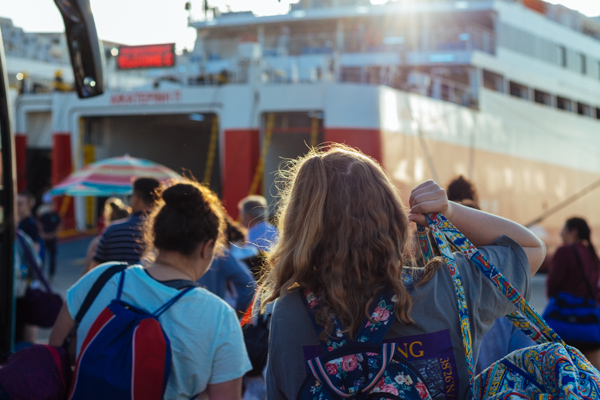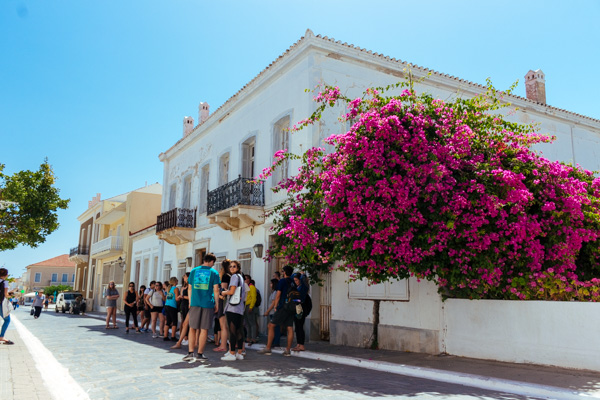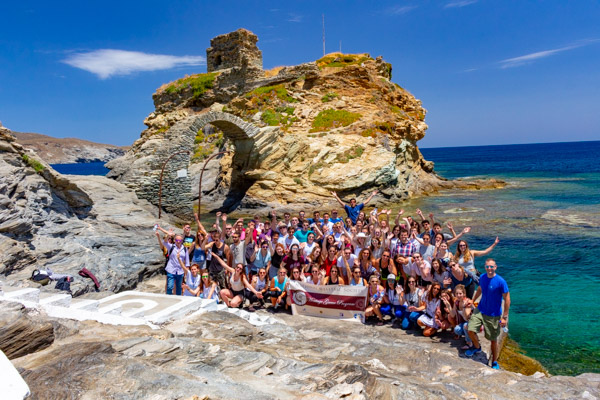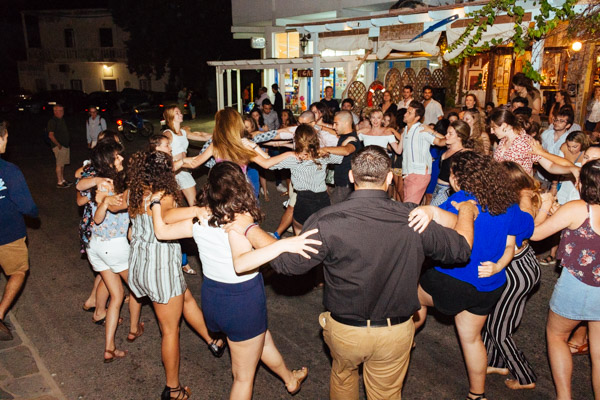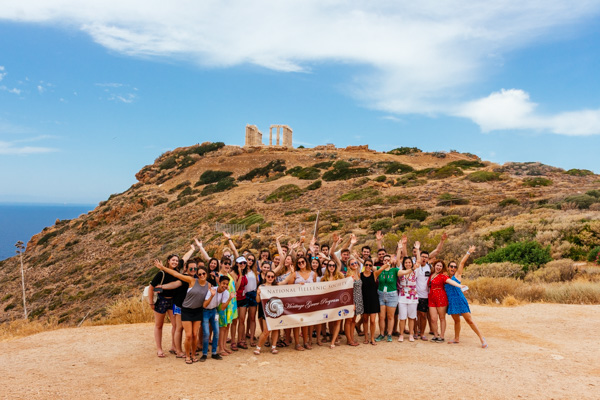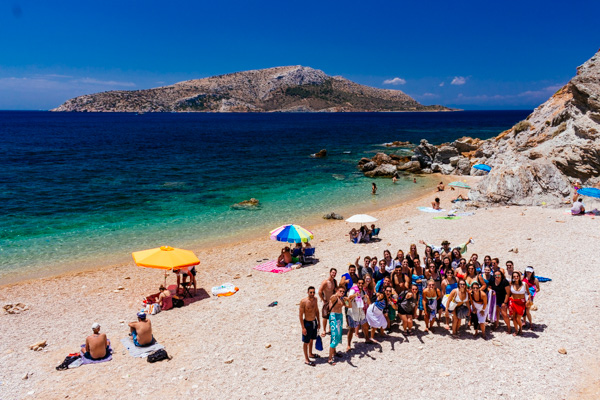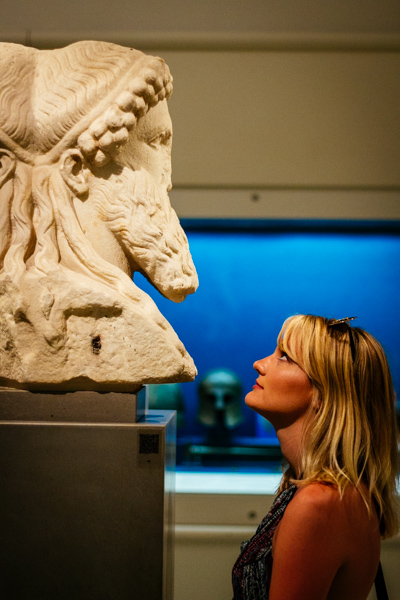The Gem of Athens
We have reached the final day of activities and no one can believe how time has flown so quickly. Rooms were inspected, and the participants were left free time to explore Athens or visit relatives.
The best was saved for last though. In the afternoon, the group visited the Stavros Niarchos Foundation Cultural Center, in Kallithea. A gem of southern Athens, it was built to be a cultural and community hub, housing the National Orchestra and the National Library, while also being an environmental park. It truly is a sight to see, breathing new life in to Athens.
What the participants saw astounded them. Taking place at the time of their visit was the Nostos Festival, which “encapsulates the idea of “nostos” (homecoming), the inexhaustible desire to return to all things familiar; familiar emotions and places, which have helped shape us and make us nostalgic. The SNFestival is an open and welcoming festival, with programming that encourages the peaceful coexistence of all people, welcoming everyone, both individually and collectively.”
Participants were left to wander and explore the foundation’s grounds, partaking in activities, or simply enjoying the view of Athens and the bay of Faliro with friends. The day was beautiful, as the sun graciously warmed everyone’s heart. But, as it was time to leave, a summer μπουρίνι (bourini, a very abrupt change of weather, usually accompanied by rain and thunderstorms) hit, leaving the participants in awe at the raging thunderstorm!
Sheltered by the foundation, the participants waited the storm out, and headed to a fantastic dinner with friends – no… now family, as they rejoiced in each other’s company, leaving lasting memories behind.
Blog editor and photographer: James (Dimitris) Voutsas
The Stavros Niarchos Foundation Cultural Center!
The main stage of Nostos festival.
A summer bourini!
Shipping makes the world go round
If it’s not evident by now, the seas play a crucial role in Greece. From beautiful getaway beaches, to open sea highways, the sea is important to every Greek. It’s no wonder that through tradition, hard work and determination, the Greek shipping industry is one of the best in the world.
That’s why the participants traveled to Piraeus, where a reception was held in their honor at the beautiful Yacht Club of Greece. Full of energy, Art Dimopoulos, Executive Director of the National Hellenic Society, introduced the distinguished guests, among them HRH Princess Tatiana Blatnik, Kate Marie Byrnes, Deputy Chief of Mission for the United States Embassy in Athens, George M. Marcus, and Dr. David G. Horner, President of The American College of Greece.
Everyone understood the importance of the meeting, which had a kindness to it, as the organizers welcomed the participants to the new family, establishing connections which are sure to strengthen the bond between the United States and Greece; linking one home to another.
Christina Bordenet was excited to be in such an environment. “The yacht club was incredible! It was so nice to spend time with all the participants on the trip. It was so awesome to meet so many inspiring people, like Princess Tatiana. There was also a wealth of networking opportunities for everyone, no matter their major. And of course, the views and the food was incredible!”
After the beautiful reception, the group visited the SS Hellas Liberty, a historic ship which played a crucial role during WW2, but also was part of the fleet of ship that kick-started the modern Greek shipping industry, solidifying Greece’s position in the global shipping trade. Participants were told the history of the ship by Dimitris Fafalios, a representative of the Union of Greek Shipowners, who also elaborated on the role of the Union, both in Greece and abroad.
After the short presentation and short film on the 100 years of the Union, the participants were free to explore the floating museum, which hid a wealth of information on Greek and Greek-American heritage. Christina found it fascinating. “The Hellenic Liberty Museum was super informative – it helped us gain a deeper understanding of just how vital shipping is to both Greece’s economy and culture. Being able to explore one of the iconic Liberty ships was such a cool experience.”
Adding to what Christina said, Alyssa Eliopulos chimed in. “The Hellenic Liberty museum was interesting because we learned about one of Greece’s most important industries. The most fascinating part was how family oriented all the shipping companies are in Greece. I love how this ties into the tight knit family aspect of Greek culture because this is an amazing example of how family bonds impact the everyday lives of Greeks.”
It has become evident throughout the duration of the program that strong family ties are the key to Greek success. Supporting one another in times of need has always guaranteed success. Be it from emigrants to the United States, all the way up to the Greek economic crisis, it’s the family bonds that allowed Greek to prosper and succeed.
Blog editor and photographer: James (Dimitris) Voutsas
From left to right, Kate Byrnes, Dr. Horner, Art Dimopoulos, George Marcus.
The Heritage Greece family under the blue sky!
Hellas Liberty Museum, moored at Piraeus harbor.
Dimitris Fafalios, representing the Union of Greek Shipowners.
Big Love for a Small Country
Greece has a weird effect on people. For such a small country, it’s charm is immeasurable. One might find it odd that those who love Greece the most, aren’t even born in Greece. Today, we met such people.
There to meet us under the shadow of the Parthenon, was Dr. John Camp, Director of the Archaeological dig of the ancient Agora. He has been working at the site since1966! In his ever-engaging tone, he gave an amazingly insightful tour of the ancient Agora, one that only a Director could give. A moment’s walk away was the latest excavation site, where Dr. Camp and the other Archaeologists took the time to show the participants around, allowing them to even dig with them! They answered any questions the participants had, much to the participants’ bewilderment. Noah Duclos was highly enthusiastic. “It was such an amazing experience to meet with Dr. Camp and to hear about the archaeological project from the man who’s been doing that work for 50 years. His willingness to share his knowledge and give us a glimpse into the work they do there was an opportunity of a lifetime.”
As the day was packed, the group boarded the buses and headed to Kolonaki, where the American School of Classical Studies is located.
It has close ties to the American College of Greece, as they are some of the oldest American educational institutions in Europe.
Founded in 1881, the American School of Classical Studies provides graduate students and scholars from affiliated North American colleges and universities a base for the advanced study of all aspects of Greek culture, from antiquity to the present day. It also contributes considerably to the dissemination of information about Greek history and archaeology to the Greek public, as well as to the international and Greek scholarly communities.
There to welcome the participants was George Orfanakos, Executive Director of the school. He explained the scope and mission of the institution, by presenting short videos of faculty and benefactors, most of whom were not of Greek descent. “They weren’t born Greek. They became Greek by choice,” is what Mr. Orfanakos told the participants. The love of Greek history, culture, and tradition is the driving force of the school and its people.
To showcase all that the school has to offer, the participants were split in to five groups, and rotated from location to location. The participants played a wonderful game with Gennadius Library’s director, Maria Georgopoulou, where they had to assemble a map of Greece. Participants also had the chance to see the Archives, where they were even shown the original notebook of Henry Schliemann, the pioneer of archaeology! Next, they visited the exhibition on Ioannis Makriyannis, one of the heroes of the Greek Revolution of 1821. Another fascinating part of the tour, was the rare books collection, which used to be part of the Blegen Library, but is now part of the Gennadius Library, where participants had the chance to see wonderful illustrations of books dating back to the 15th century.
Lastly, linking the archaeological dig at the Agora, which the school is closely connected to, participants had the once in a lifetime opportunity to go into the depths of the Wiener Laboratory, where American and international scholars of archaeological science in the eastern Mediterranean and adjacent areas are given the tools and resources to answer a variety of scientifically-based questions mainly in the fields of bioarchaeology, geoarchaeology, archaeobotany and zooarchaeology!
At the end of a full day of activities, participants were served a delicious lunch in the main hall. It was there that we caught up with Mr. Orfanakos, who was very pleased to receive the Heritage Greece program. “It was a great joy to have the Heritage Greece Program from the National Hellenic Society come and visit the American School of Classical Studies in Athens. It was extraordinary to see these kids come here and recognize that, although they were born Greek, they were not Greek by choice. That the people here at the American School, and those who established the school, who chose to become Greek, established this place to preserve, promote, protect Greece’s past, from 1881, straight through to today. So, I think there was a deep appreciation.
For me, the most important thing was the awareness we are building, and understanding that this place exists. To recognize the scope and work of this institution.
If there is one thing I hope they take away from this, is passion; it’s the passion that people can have to preserve a heritage, which sometimes isn’t even their own. Hopefully, in that way, Greek Americans and people that participate in the Heritage Greece Program, by seeing others appreciate Greece’s past and realizing that there is a future for it, will begin to realize just how blessed they are, being part of the omogenia and diaspora, and how important it is to carry that torch forward.”
Christian Roumelis thought, “it was interesting to be able to see all the history and how it shaped modern Greece”, with Noah reflecting, “seeing the work done by Americans and Greeks to preserve Greek history from the classical period to the modern era was a wonderful experience. My favorite thing was definitely seeing Schliemann’s journal from his discovery of Troy and Mycenae, because of how significant of a person and event that was.”
On the same day, the President of the American College of Greece, Dr. David G. Horner, graciously opened his house to the participants and peers of the program. A warm reception, as everyone who made this year’s program possible was there. The President made all the guests feel welcomed, as though part of the family, a family of which they are all now a part of. Lucas Bennett felt particularly welcomed.“I thought the Presidents reception was really inspiring. Being around successful Greek Americans who really want the best for me and want to support me later in life, made me feel really connected to my community.”
One of the Greek-Americans there, George Koskos, one of the founders of the NHS, was touched by all the aspiring Greek-Americans he saw. “The beautiful, handsome, young Greek-American students, have taken me, personally, to another level. I thought I have accomplished a lot in my life, but knowing full well what this program is doing for these students… it has, truly, taken me to another level.”
Food and good company brought laughter and mirth. In the beautiful summer sunset, it was a night to be remembered.
Dr. John Camp showing the participants around the excavation site of Stoa Poekile.
The American School of Classical Studies and the Heritage Greece Program!
A family photograph at the President’s Reception.
Cruising the Aegean Sea
Blue; it’s everywhere in Greece. From sky to flag, it’s a color deeply associated with Greece’s past, present, and future. And what better way to explore the open Aegean sea than a cruise of the Argosaronic gulf!
Situated due south of Athens, it has a rich history, spanning from antiquity to modern times. Most notably, the battle of Eleusina, where the Athenian navy battled the Persian navy, in what would become the largest naval battle of antiquity!
Upon reaching the harbour, the excitement was palpable. Everyone was looking forward to spending the day sailing the open blue sea. People boarded, anchors were raised, and off they were. An hour of gentle sailing was enough to wet everyone’s appetite for a swim. The two boats eventually reached the small island of Fleves. A small paradise. No one could believe the clarity of the waters at a place so close to Athens. Alexandra Sakellos was intrigued, as “the cruise was a terrific experience that really took me off the map. I knew we were somewhere in Greece, but geographically I was unsure where. I also had a chance to unplug from technology and connect with friends.”
And a day with friends it was. Laughter could constantly be heard, despite the music to which participants were always dancing to. As one would imagine, it didn’t take long for Greek music to play. Everyone got out of the sea and joined in the middle of the deck, to dance to their hearts’ content. David Lilla absolutely loved the energy on board. “The most exciting part of the day was being able to dance with friends while on the boat. We had an awesome mix of both Greek and American pop/traditional music. It was like being at a club on the sea!”
The cruise thrilled everyone. The beautiful location and good company created a friendly atmosphere that no one wanted to leave.
Sophia Heller was enthralled. “The cruise was purely magical. The waters were turquoise and crystal clear. The boats were perfect for dancing; we even did some Greek dancing before lunch. The food was refreshing and grilled on deck, and everywhere we looked was a perfect view. I couldn’t ask for more.”
Returning in the evening, everyone was content. It was a beautiful day, spent at a beautiful location with beautiful people.
Join us tomorrow as we visit the ancient Agora in the center of Athens for an exclusive tour by Dr. John Camp, Director of the excavation, and the American School of Classical Studies.
Sailing in the beautiful Aegean. What more could you ask for.
Participants at the island of Fleves, enjoying the beautiful sea.
The blue and white are deeply Greek colors.
Town and Family
Green-grocer’s markets aren’t the only markets around. When you want to find amazing deals and little trinkets of history, where do you go? The flea market.
Situated in Monastiraki (little chapel), it sits right under the Parthenon, a constant reminder of the rich history Athens has. It also gave them the opportunity to put their Greek skills to the test!
After some bartering, and a few tavli (backgammon) sets later, the group had light lunch at Falafel House. From there, it was a walking distance via Thisseio and Kerameikos cemetery, the resting site of ancient Athens, to the buses, which took them to the Foundation of the Hellenic World, whose mission is “the preservation and dissemination of Hellenic history and tradition, the creation of an awareness of the universal dimension of Hellenism and the promotion of its contribution to cultural evolution.” Participants were taken to “Tholos”, a dome-shaped Virtual Reality theatre, where they were taken on a digital, interactive tour of Athens.
Having spent some time downtown, taking in as much of Athens as they possibly could, it was time to spend the evening with family. Peers and staff opened up their homes, showcasing what true Greek “φιλοξενία” (hospitality) is all about. It was a touching night, as participants bonded with their hosts.
Trifonas Asproulis was a peer who embraced the idea of a host family dinner. For Clare Clifford, “I feel like I am family. I feel like I am home. I am so happy I had an opportunity to experience a true Greek homemade dinner with these amazing people.”
Sharing the sentiment, Amara Grubor said, “I feel so lucky to have had this dinner and experience. The food, love and hospitality were incredible. It’s amazing how our culture breeds us to make strangers feel like family.”
For Marcel Isper, it was a familiar environment. “This dinner reminds me of the dinners I have at home, where my Dad sings and we just sit around the table having dinner, just like we did today. I felt welcomed the second I stepped through the door and I definitely felt like I was a part of the family.”
Stefi Trivyza was another of this year’s peers that graciously held a dinner, for no less than 6 participants! Kalli Vellis was very enthusiastic. “Stefi was a great host. I loved meeting her family and friends! By far, it’s my been my favorite night of the program.”
Kristen Vrionis chimed in and agreed. “I loved going to Stefi’s home and meeting her family and friends. We all had a great time eating souvlaki, ice cream and drinking Greek wine. It was one of my favorite nights of the program!”
Michael Taormina loved the social aspect of the dinner. “I love to meet new people. Not only did we get to meet her family and her friends, but they were also very nice and friendly.”
Alexis Grias enthusiastically complimented Stefi on her hosting. “Not only is Stefi a great peer, but she is also a great hostess! Herself, her family and friends were so fun and it was great to meet other Greek people and just drink and socialize with good food for hours.”
Lucas Bennett echoed the sentiment. “Stefi was a great hostess. She showed us a really cute kitten that she rescued and then gave us a delicious meal. She also introduced us to her family and some of her local friends, and everyone was super nice and welcoming.”
Getting to know others over food is a staple Greek experience. Sophia Callanan was happy to be part of the host dinner. “It was so nice being able to spend a night with Stefi’s family and friends. We had so much fun getting to know each other over delicious souvlaki. This experience is definitely going to be a night to remember!”
Noah Duclos thoroughly enjoyed and understood the value of the host family dinner. “I really enjoyed having dinner and exploring the local suburb with our host family. It went a long way toward continuing to feel integrated in the local community, especially in a context away from the program at large.”
A night to remember for all involved, new families were made, friendships that will last for life. This is what Heritage Greece is all about.
Monastiraki square! From left to right, the old mosque, the Acropolis, Metro station.
Exploring ancient Athens in an interactive experience at Hellenic World.
Host family dinner with Art Dimopoulos!
Host family dinner with VP Dimitrios Andreou and Vassia Comis!
Host family dinner with Ariadne Koutitsa!
Host family dinner with Stefi Trivyza!
Host family dinner with Trifonas Asproulis!
It’s the Everyday Things
Heritage Greece has always been about offering experiences. What one might find trivial, could be the most exciting for another. Yesterday, the participants had the opportunity to experience a Greek laiki, spend time with the Mayor of Athens, George Kaminis, and learn about social and digital initiatives to improve life in Athens.
The laiki, or market, usually takes place once a week per area, and it has everything. From plants to clothes, and fresh grocery to fish, the laiki is a bustling place. Filled with all kinds of smells of fresh produce, loud shopkeepers shouting “fresko, fresko” (it’s fresh, it’s fresh!), trying to persuade you that “their” produce is better, it’s the true embodiment of every day Greek life. It’s where the whole neighborhood meets, catches up on weekly news, and shares their joys and sorrows.
Bustling with people and full of energy, it was a fascinating experience. Alex Assimoglou was particularly impressed. “Grecian hospitality comes alive at the local farmers market. Merchants are both helpful and friendly when introducing you to the freshest produce Greece has to offer. Just a smile can land you a complimentary piece of fruit. This outing was an unexpected contrast to American customs regarding purchasing fruits and vegetables.”
Leaving the market behind, participants headed to the center of town, to the prestigious town hall of Athens. They were given a tour, then lead in to the main conference area, where they met Mayor of Athens, George Kaminis. Taking time out of his busy schedule, he was warm and cordial, bonding instantly with the participants as he had a connection to the United States, being born in Brooklyn.
He inquired about Heritage Greece, to which Art Dimopoulos, Executive Director of the National Hellenic Society, explained the scope and ambition of the program. The Mayor then opened up the floor to questions, which came flooding in as participants wanted to know about how the city of Athens deals with issues, such as graffiti, the homeless, and refugees, under the shadow of the economic crisis. When asked how Athens, and Greece in general, was able to keep it together, he answered “it’s the family bonds,” something Greek-Americans know well, and will be able to experience the Greek version tomorrow, at the Host Family Dinner.
Having to leave to attend a meeting, the mayor stood for a group picture and parted ways with the participants, who went on to visit an inspiring initiative. Housed in the same building, the Athens Partnership and the Athens Digital Lab aim to bring innovation to aspects of everyday Athenian life.
Natalie Weeks, Strategy and Partnerships Director for Athens Partnership, explained that the Athens Partnership serves as a technological hub and liaison to the Municipality of Athens, bridging the private and public sector, creating opportunities, particularly for the Greek youth that still sees incredibly high unemployment rates. Right behind her was the workshop of Maker Space, a recently opened workshop that allows students of primary, secondary, and senior schools to experience the latest technological advancements, ranging from 3D printing to virtual reality experiences.
The Athens Digital Lab, aids the digital transformation of Athens, by investing, researching, and creating innovative ways to enhance the lives of Athenians. Antonis Papadopoulos, Project Manager, and Konstantinos Hampidis, Chief Digital Officer of the Athens Municipality, took the time to present what Athens Digital Lab is, allowing participants to gain insight on digital governance.
Alex Teplitz was interested and optimistic about the initiatives he saw. “I believe the initiatives will be instrumental to the revival of Athens. It is important to advance the city technologically, and, as a whole, to improve the quality of life. Even the smallest sector should not be left behind.”
To end the day off, participants travelled through rainy Athens, a rare sight it must be said, back to Aghia Paraskevi to attend Greek Culture Seminar by Dr. Katsas.
Join us tomorrow for a very special, family-oriented, edition of the blog. It’s host family night!
You can just smell the freshness at the laiki!
Mayor of Athens, George Kaminis, poses with the Heritage Greece Participants.
The Athens Partnership and Athens Maker’s Lab bridge private and public sector.
Participants learning about digital innovation at Athens Digital Labs.
Bon Voyage!
Sadly, it was the final day at the island. But that didn’t put spirits down.
For many, the day started with a beautiful liturgy at the local chapel in Batsi. Alexandra Sakelos was blissful. “It was very serene. Hearing the bells pierce through the air made everything special and wasn’t anything I had seen in the States before.”
Others, spent their time exploring every nook and cranny of Batsi. They all ended up at the beach though, where they had a light lunch and a beach party!
At six, it was time to depart this lovely island, which for three days filled everyone’s heart with happiness, content and peace. The departure was bittersweet, as no one wanted to leave this small paradise. Alexandra was adamant about this. “The culture of Andros was very relaxed and everybody was just enjoying life and their surroundings, connecting to the moment. Simply put, I don’t want to leave!”
The participants, having experienced another side of Greece, one which does not involve the hectic lifestyle of Athens, talked highly of Andros. Sophia Heller was such a person. “I think that Andros was different from Athens because Athens is very much a city, whereas Andros has a certain type of island magic that feels both timeless and calming. The capital of the island was less industrial than Athens, and the buildings themselves were colorful and welcoming. I found it interesting that more people on Andros immediately started speaking to me in English than in Athens, probably because more tourists visit the island shops than those in Athens. I also found it interesting that the food was of similar style and quality at both locations. Although it was enjoyable to Greek dance in Athens, it felt more natural and rewarding to Greek dance in the streets of Andros, and it was a night that I will never forget.”
Travelling in to the sunset, the first week of Heritage Greece came to a close. Stay tuned for the second, exciting week!
Blog editor and photographer: James (Dimitris) Voutsas
Beach Party!
The participants’ last mpanio at Andros!
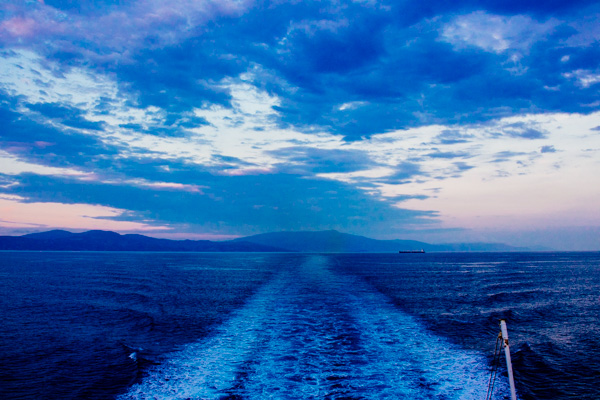
As the first week comes to a close, a second week filled with activities is on the horizon!
Unparalleled Beauty
Imagine waking up to the sun gently kissing the sea, a sweet summer breeze making your hair sway, and friends to share a smile with. Some would call this paradise.
Participants were in awe of the natural beauty Andros had to offer. As the small country roads took us to the beautiful beach the locals called “Tis Grias to Pidima”, it further sunk it. Beautiful greens and blues comprised the sea, the cleanest they had ever seen. Diana Kawka was immensely impressed.
“On our decent down from the mountains of Andros we saw the small, historical town of Korthios, located within a cove carved out by years of erosion and weathering. As soon as we stepped off the bus, we were hit by a gust of fresh sea air, tasting the salt and smelling the natural musk of the city. The town was made up of the iconic blue and white houses seen on the many postcards and Instagrams, vibrant flowers of sundry colors growing along walls and hanging down from terraces. It was a twenty-minute walk to Tis Grias to Pidima. As we rounded the final hill and made our way down the steps we saw a beautiful beach meeting the turquoise blue water with a massive rock column rising out of the water. The beach was surrounded by tall cliffs and was practically empty, with a few locals enjoying the crisp water. I’ve never experienced a beach quite like Tis Grias to Pdiima and don’t think I ever will again, but is, definitely, a place I hope to visit again.”
Alexandra Sakelos was a bit nostalgic. “Going on the cliffs reminded me of the story of how my pappou learnt to swim; his brother pushed him off! So, I was afraid that would happen to me. Luckily, it didn’t, and I thoroughly enjoyed the beach.”
After spending time at the beach and having a hearty lunch, it was time to visit Kentro Perivallontikis Enimerosis (Center for Environmental Education). The participants learned of the initiatives the center has undertaken, to train students from Andros, and not only, in the value of preserving the beautiful Greek landscape.
The day was not over though. A visit to Panachrantou monastery followed, where the hypnotic mysticism left the participants in awe. A monastery on the side of the mountain, it brought out the best in everyone. Diana was touched by the visit. “It was beautiful and very spiritual. I felt closer to the church I grew up with and my mother who is a very devout Orthodox. When the priest described the miracle of the monastery, there was not a dry eye to be seen. It reminded me a lot of this story of my pappou who served during WW2 and was chased into a church. Eventually, it was set on fire, and as the flames were approaching them, they stopped at the icon of Virgin Mary.”
As the day came to a close, the participants enjoyed a souvlaki in Batsi, right on the seafront.
Blog editor and photographer: James (Dimitris) Voutsas
Tis Grias to Pidima! A natural wonder.
The participants learning what the KPE’s initiatives are.
A liturgy in a small mountain monastery.
The Smell of the Sea
What would Greece be like without its islands? Fundamental to the success of the country, sailing between islands and the commerce this brings, has been at the core of Greek civilization for eons. What better place to learn about this rich history than Andros, an island in the Aegean Sea.
Setting out early in the morning from the port at Rafina, the excitement was evident. For Kristen Vrionis, it was a trip down memory lane. “My parents would go island hopping when I was younger and we’d use ferries all the time, so being on one now reminded me of my childhood. It brought back a lot of good memories.”
For most, having never travelled to Greece, it was an opportunity to see a different part of the world, where sea and sky become inseparable, allowing one to discover true inner tranquility – γαλήνη, as Greeks would say.
The journey didn’t last long, and the day was filled with activities. With the group split up into smaller groups, each visited a different point of interest on the island; the fascinating local Archaeological Museum, the inspiring Museum of Contemporary Art, the Kaireios library with its fantastic collection of books, some of which even dating back to the 16th century, and, finally, to a local sweet maker, Laskaris, for almond based sweets. Amanda Prokos thoroughly enjoyed her experience. “I thought the library was so cool. It was mind-blowing to see all these books that date back to the 15th century and are still intact. At the sweet shop, the almond cookies were sooo good. I felt so bad going back for more!”
The final location was the square of Afanis Naftis (the Unseen Sailor), where the group marveled at Andros’ natural beauty.
We returned to Batsi, quickly checked in, then headed out to Lagoudera for dinner. As the music kept on playing, the mood was getting ever cheerier. When the musicians played the Syrtaki from Zorba the Greek, something unforgettable happened. Everyone got up and danced… in the street!
Kristen later told us, “I thought it was really cool and I was impressed by the dancing of the other kids. They pulled off moves I didn’t even know were part of Greek dancing. I don’t really dance myself, but the energy was amazing! We stopped traffic, bystanders took pictures and it must have been an unusual experience for the locals!”
The dancing was something the group immensely enjoyed. Amanda loved it. “It was really fun to see and dance, because I love Greek dancing. Whether you are dancing or just watching, it boosts everybody’s mood.”
An amazing end to a busy day. But boy, could you feel the excitement and happiness! Christiana Konugres couldn’t be happier. “How could you not be happy?! You’re in Greece, eating fantastic food, listening to live music – by the beach – eating karpouzi!”
Blog editor and photographer: James (Dimitris) Voutsas
The journey begins! Next stop, Andros.
Participants were amazed at the local architecture.
Just bellow the square of Afanis Naftis, the team gathered for a picture.
This is what happens when Greeks need to dance, no matter what!
From Temple to Temple; Part 2
While the Parthenon takes the spotlight, the Temple of Poseidon has its own right to fame. Inspiring myth and legend itself, the area was used since 1500 BC as a site of worship. Key to the myth of Theseus and the Minotaur, Cape Sounio is where king Aegeus stood and looked for Theseus, as he returned victorious.
Simply standing next to the Temple and looking out at the beautiful deep blue Aegean Sea, one can understand why it played such a crucial role in Greek antiquity. Built right at the edge of the cliff, few places inspire such awe. In this day and age, it stands as a true wonder. Not wanting to leave the temple, the participants went for a swim at a beautiful cove nearby. Who knew that there was such a beautiful beach so close to a metropolis? Christiana Konugres was thrilled by the excursion.
“Sounio was fantastic! It was amazing to see the beautifully crafted columns standing along the Aegean Sea. It was incredible to think it was constructed thousands of years ago and, that despite the salt and harsh winds, it still stands so strong. Cape Sounio was amazing as well. I have never seen such beautiful clear turquoise water. We had a wonderful time swimming and a beautiful lunch. The καρπούζι (watermelon) was so good!”
Diana Kawka was equally impressed and amazed.
“I thought Sounio was beautiful. Before this trip, I had never been out of the U.S., let alone been to Greece. So, having the chance to see such a historical site, especially in such a beautiful place, was an amazing opportunity for me. I just thought of how long the temple had been there and how generations of Greeks, including my own family, had been there and seen it, just like I had. The whole cape Sounio was amazing too. I’ve only seen such clear blue water in movies and it was hard to believe that it actually exists here in Greece.”
After lunch and a swim, it was time to visit another landmark of Athens. The Benaki Museum.
Founded by Antonis Benakis, he had the foresight to know that history should be preserved, if we are to build a better future. Caring about society, the family set up many museums around Athens, all aiming at the same thing; to make better people and citizens.
With Dr. Kitroeff’s wonderful insight into the museum, the participants spent some time exploring the museum’s wealth of Hellenistic exhibits, ranging from artifacts of pre-classical ages, all the way up to contemporary photography exhibitions. Through its intertwining hallways, there was something new to be found around every corner. Frances Asbury was fascinated.
“While I was at the museum, I felt so connected to my heritage. I was able to learn more about the relics, history, and consequences of the Greco-Turkish War and gained a much better understanding of the lives and hardships of my family. Additionally, I loved seeing the formal and casual wear that was on display from centuries ago; it helped me visualize what ordinary life in Greece might have looked like for my ancestors.”
What the museum successfully did though, was ignite the imagination. Christina Kerner was moved and inspired.
“The museum allowed me to experience a vast array of Greece’s artistic contributions to the world, from ancient sculptures to Byzantine iconography. I especially liked viewing the artifacts that might otherwise have been forgotten if they weren’t preserved in a museum, such as bridal fashion from the eighteenth and nineteenth century. As an artist myself, I was excited to discover how the Greek art of antiquity continues to influence modern art today.”
The connecting link between the floors of the Benaki Museum, is how Greek culture is expressed. Each family does it a bit differently. Frances Asbury told us,
“I was lucky to grow up in a family who was very proud of their Greek heritage so whenever we were all together we would celebrate our “Greekness” with food, jokes, and family stories. My Γιαγιά and Παππού were such generous people and so happy to talk with us about what it meant for them to Greek. Family is so important to Greek culture and in this way, through our family, we preserve our culture.”
Next? A trip to the beautiful island of Andros! The blog will be back on Monday after the trip. Stay tuned, and keep an eye on our Facebook and Instagram to follow along our trip.
The Temple of Poseidon. Where myth meets the present.
This is what the Aegean Sea experience is all about!
Our trip to the Benaki Museum brought us face to face with our heritage.
